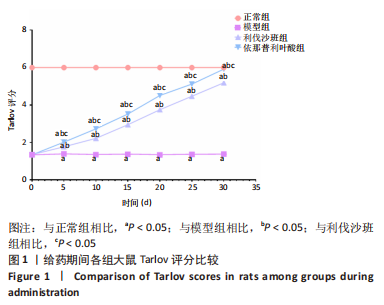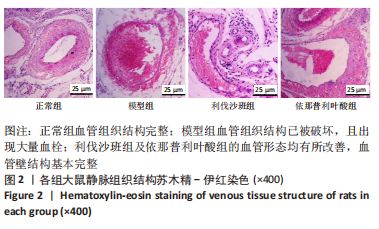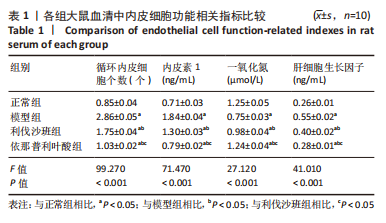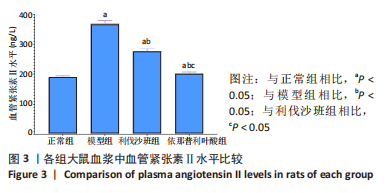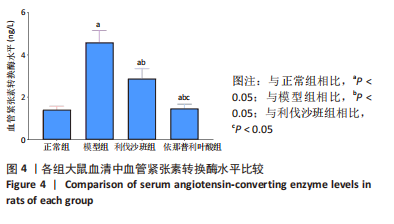[1] HUANG C, TIAN J, YUAN C, et al. Fully Automated Segmentation of Lower Extremity Deep Vein Thrombosis Using Convolutional Neural Network. Biomed Res Int. 2019;7(9):3401683.
[2] 万函. 参附注射液调节NOS/NO信号通路保护LPS损伤的脐静脉血管内皮细胞的作用及机制[D].南昌: 南昌大学,2021.
[3] GALSKLINT J, KOLD S, KRISTENSEN SR, et al. Validation of Postsurgical Venous Thromboembolism Diagnoses of Patients Undergoing Lower Limb Orthopedic Surgery in the Danish National Patient Registry. Clin Epidemiol. 2022;14:191-199.
[4] 丁丁,赵志坚,陈坤峰. Hcy、LPA及TGF-β1在创伤性骨折下肢静脉栓塞中的预测价值[J].分子诊断与治疗杂志,2022,14(1):133-136.
[5] TUNG-CHEN Y, PIZARRO I, RIVERA-NÚÑEZ MA, et al. Sonographic evolution of the superficial vein thrombosis of the lower extremity. J Ultrasound. 2021;24(3):253-259.
[6] 钱爽,赵益明.血管内皮细胞参与静脉血栓形成的研究进展[J].中华血管外科杂志,2021,6(4):292-296.
[7] 韩晓晓. AngⅡ,Ang(1-7)在肺血栓栓塞症中的表达及意义[D].长春:吉林大学,2019.
[8] 周文婷,胡扬.急性低氧暴露下运动模拟急性高山病发生中血清ACE活性,AngⅡ水平及其基因多态性研究[J].山东体育学院学报, 2014,30(2):63-69.
[9] WANG K, GHEBLAWI M, NIKHANJ A, et al. Dysregulation of ACE (Angiotensin-Converting Enzyme)-2 and Renin-Angiotensin Peptides in SARS-CoV-2 Mediated Mortality and End-Organ Injuries. Hypertension. 2022;79(2):365-378.
[10] WILKERSON RG, WINTERS ME. Angiotensin-Converting Enzyme Inhibitor-Induced Angioedema. Emerg Med Clin North Am. 2022;40(1): 79-98.
[11] NEEDLEMAN L, CRONAN JJ, LILLY MP, et al. Ultrasound for Lower Extremity Deep Venous Thrombosis: Multidisciplinary Recommendations From the Society of Radiologists in Ultrasound Consensus Conference. Circulation. 2018;137(14):1505-1515.
[12] 原士超,范红燕,赵庆.肺动脉CTA联合间接法盆腔下肢静脉CTV诊断静脉栓塞症的临床效果分析[J].中国医学工程,2021,29(8): 22-25.
[13] 任宇,管欣,张瑶,等.依那普利叶酸片与依那普利片预防高血压患者卒中的药物经济学评价[J].中国药房,2021,32(23):2880-2884.
[14] HOU J, YAN G, LIU B, et al. The Protective Effects of Enalapril Maleate and Folic Acid Tablets against Contrast-Induced Nephropathy in Diabetic Rats. Biomed Res Int. 2018;2018:4609750.
[15] 张学琴. 利伐沙班与辛伐他汀在大鼠体内的药物相互作用[D].石家庄:河北医科大学,2020.
[16] 黄剑锋,肖善花,黄绍烈,等.马来酸依那普利叶酸片联合阿托伐他汀对大鼠主动脉平滑肌细胞内质网应激的影响[J].中国临床药理学杂志,2022,38(4):338-341+351.
[17] 张微,崔玉莹.血管超声在下肢静脉血栓诊断中的应用研究[J].实用医技杂志,2022,29(1):77-79.
[18] 罗翠芳,欧阳莉,吴晶.三主体预警联动模式在48例全髋关节置换术围术期下肢静脉血栓预防中的应用报告[J].护理实践与研究, 2021,18(23):3633-3634.
[19] 陈成帷,潘哲尔,周也立,等. 常规止血带下膝关节镜手术后早期深静脉血栓的发生率及危险因素分析[J]. 中国骨伤,2018,31(9): 829-834.
[20] 张玉玲,陈淑琴,黎万琳.术中使用空气波压力治疗仪预防手术患者下肢静脉血栓的探讨及研究[J].黑龙江医药,2021,34(6):1442-1444.
[21] 田坤,孟路阳,陈世伟.利伐沙班对下肢动脉硬化闭塞症大鼠血管内皮功能及p38MAPK/NF-κB通路的影响[J].中国药师,2018,21(5): 757-760+765.
[22] 张安兵,袁小玲,夏秀琼,等.低剂量利伐沙班应用于急性肺栓塞的近期疗效及安全性研究[J].国际呼吸杂志,2022,42(4):275-278.
[23] 赵丹.卡维地洛联合依那普利治疗高血压并心力衰竭的临床疗效及其对血压及心功能的影响[J].临床合理用药杂志,2021,14(33): 43-45.
[24] 赵信科,蒋虎刚,王新强,等.依那普利叶酸片治疗H型高血压的疗效及安全性的Meta分析[J].实用中医内科杂志,2022,36(1):47-51+144-148.
[25] 王飞.下肢静脉血栓栓塞患者利伐沙班治疗前后血浆F1+2、Fg、DD水平表达及意义[J].实验与检验医学,2020,38(5):868-871.
[26] ZUO J, HU Y. Admission deep venous thrombosis of lower extremity after intertrochanteric fracture in the elderly: a retrospective cohort study. J Orthop Surg Res. 2020;15(1):549.
[27] FAUSTINO EVS, SHABANOVA V, PINTO MG, et al. THrombosis Epidemiology in Ill Adolescents (THEIA) Study Investigators. Epidemiology of Lower Extremity Deep Venous Thrombosis in Critically Ill Adolescents. J Pediatr. 2018;10(201):176-183.e2.
[28] 李秀萍,葛智慧.个体化预测胃结直肠癌患者术后下肢静脉栓塞的风险及列线图模型的建立[J].实用癌症杂志,2022,37(1):60-64.
[29] 田玉林. 右心功能变化和下肢静脉血栓分布特征在肺栓塞诊断和危险分层中的意义[D].合肥:安徽医科大学,2020.
[30] 孙虎,刘金昊,徐益鸣,等.利伐沙班对下肢静脉血栓栓塞症患者血流动力学及血管内皮功能的影响[J].国际医药卫生导报,2020, 26(12):1748-1751.
[31] KRÜGER-GENGE A, BLOCKI A, FRANKE RP, et al. Vascular Endothelial Cell Biology: An Update. Int J Mol Sci. 2019;20(18):4411.
[32] 李少辉,李兵,唐健荣,等.针刺法对下肢静脉曲张患者的血液流变学、内皮细胞功能及生活质量的影响[J].深圳中西医结合杂志, 2017,27(20):51-52.
[33] LIU Y, XIONG M, ZHOU F, et al. Effect of baicalin on gestational hypertension-induced vascular endothelial cell damage. J Int Med Res. 2020;48(10):30006.
[34] 盛志康. 猪眼角膜微结构、内皮细胞活性及基因表达研究[D].天津:天津农学院,2020.
[35] 王瑶瑶. 双清平化方对MS大鼠血压及IR, ACE, AngⅡ的影响[D].唐山:华北理工大学,2020.
[36] 张碧莹. 蛋清肽ACE-肾素抑制作用机制及吸收途径研究[D].长春:吉林大学,2021.
[37] 其布尔,李阳,韩轩茂.血管紧张素Ⅱ1型受体在血小板中的表达及对血栓形成的作用[J].血栓与止血学,2021,27(1):176-178.
[38] 王婷,陈安琪,薛雅馨,等.急性ST段抬高型心肌梗死患者血清中sACE2, AngⅡ, Ang1-7表达水平及临床意义[J].中国循证心血管医学杂志,2021,13(5):619-622.
[39] 张杰,李小刚,宋莉华.低强度有氧运动对自发性高血压大鼠血压及其ACE2,AngⅡ含量的影响[J].中国老年学杂志,2022,42(5): 1175-1178.
[40] 袁静云. 电针对自发性高血压大鼠肾组织ACE2, Ang(1-7), AngⅡ的影响[D].北京:北京中医药大学,2019.
|

